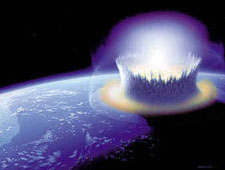
Sixty-five million years ago the cataclysmic impact of a gigantic meteor disrupted the world's climate and wiped out most flora and fauna on Earth, including the dinosaurs. This painting by Don Davis depicts the scene a few seconds after the body struck just north of what is now Mexico's Yucatán peninsula. A new study now suggests that this impact may have been one of several related events.
In 1991 a modern scientific “whodunit” was solved when geologists identified a deeply buried, 180-kilometer-wide crater in the Yucatán peninsula. Now known as Chicxulub, the scar resulted from the impact of a 10-km asteroid or comet nucleus 65 million years ago that triggered global tidal waves, worldwide firestorms, and massive earthquakes. When the planet finally returned to normal, the dinosaurs and the majority of all then-living species had gone extinct, paving the way for mammals to evolve and dominate Earth.
Now a new study suggests that Chicxulub might not have been an isolated event. Rather, it seems the dinosaurs may have been the victims of a one-two impact punch.
Simon P. Kelley (Open University, United Kingdom) and Eugene Gurov (National Academy of Ukraine) reexamined the age of a buried 24-km-wide Ukrainian crater known as Boltysh. As recently as 1993, scientists had determined this impact to be 73 million years old. However, through a number of isotopic experiments, Kelley and Gurov refined that date to 65.2 ± 0.6 million years. By comparison, Chixculub’s age is 65.5 ± 0.6 million years.

The Boltysh impact event occurred some 65 million years ago when a meteor impact crated a 24-kilometer-wide crater in the Ukraine.
S&T diagram.
The overlapping uncertainties strongly suggest, (but don't prove) that these two impacts occurred simultaneously or nearly so. By extrapolating Earth's current cratering rate backward in time, Kelley believes a Boltysh-sized crater should appear every 1.8 to 3.3 million years. To see two unrelated impacts so close in age is unlikely, though not impossible. "The trouble is that with only two craters, random impacts are not outside the realm of possibility, says Kelley. Despite the range of published errors, "I would be fairly confident that there was only a 250,000-year difference [between them]." It’s "highly probable" the two craters are linked.
What's more, Earth’s surface is approximately 3/5 water. Therefore, if two related objects hit land, another three should, statistically, have splashed down in the oceans. However, the seafloor bears no obvious trace of these — they would have been subducted down into the mantle long ago.
If the dinosaurs did indeed endure multiple hits, scientists might be able to say something about the nature of the impactors. Asteroids tend to travel alone, (though pairings do exist), while comets are thought to sometimes arrive in bunches. A gravitational disturbance in the Oort Cloud or Kuiper Belt — the massive comet reservoirs found at the outer reaches of our solar system — could dispatch a swarm of dirty snowballs inward toward the Sun, and therefore Earth. Such impacts could come hundreds of thousands of years apart. Another possible cometary multiple-impact source is a comet that broke into pieces after passing too near a planet (the fate of Shoemaker-Levy 9) Such impacts would happen close together.
Chicxulub was still the big killer, however. The sizes of the two craters imply that Boltysh hit with only about 1/400 as much force.
Kelley's next step is to derive isotopic ages for other craters with roughly comparable ages. Many craters are dated merely by stratigraphic evidence, which is a less accurate dating method than using an isotopic chronometer. Perhaps a third, theory-clinching 65-million-year-old crater exists, and it has simply been assigned the wrong age. Boltysh's assumed age was in error by some 8 million years — others could be off by that amount or more.
Kelley and Gurov present their findings in the August issue of Meteoritics and Planetary Science.
 0
0
Comments
You must be logged in to post a comment.